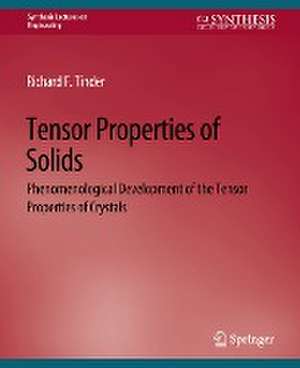Tensor Properties of Solids, Part One: Equilibrium Tensor Properties of Solids: Synthesis Lectures on Engineering, Science, and Technology
Autor Richard F. Tinderen Limba Engleză Paperback – 31 dec 2007
Din seria Synthesis Lectures on Engineering, Science, and Technology
-
 Preț: 386.95 lei
Preț: 386.95 lei -
 Preț: 395.91 lei
Preț: 395.91 lei -
 Preț: 319.00 lei
Preț: 319.00 lei -
 Preț: 284.04 lei
Preț: 284.04 lei - 15%
 Preț: 492.18 lei
Preț: 492.18 lei -
 Preț: 390.74 lei
Preț: 390.74 lei - 15%
 Preț: 576.88 lei
Preț: 576.88 lei -
 Preț: 384.91 lei
Preț: 384.91 lei -
 Preț: 315.05 lei
Preț: 315.05 lei - 20%
 Preț: 584.81 lei
Preț: 584.81 lei - 17%
 Preț: 458.16 lei
Preț: 458.16 lei - 20%
 Preț: 583.87 lei
Preț: 583.87 lei -
 Preț: 396.42 lei
Preț: 396.42 lei - 15%
 Preț: 640.22 lei
Preț: 640.22 lei -
 Preț: 324.47 lei
Preț: 324.47 lei -
 Preț: 212.97 lei
Preț: 212.97 lei -
 Preț: 234.64 lei
Preț: 234.64 lei - 20%
 Preț: 328.83 lei
Preț: 328.83 lei -
 Preț: 389.70 lei
Preț: 389.70 lei - 15%
 Preț: 524.11 lei
Preț: 524.11 lei -
 Preț: 417.88 lei
Preț: 417.88 lei - 15%
 Preț: 579.32 lei
Preț: 579.32 lei -
 Preț: 350.06 lei
Preț: 350.06 lei - 15%
 Preț: 519.11 lei
Preț: 519.11 lei -
 Preț: 221.25 lei
Preț: 221.25 lei - 15%
 Preț: 522.50 lei
Preț: 522.50 lei -
 Preț: 384.36 lei
Preț: 384.36 lei - 15%
 Preț: 629.29 lei
Preț: 629.29 lei -
 Preț: 383.99 lei
Preț: 383.99 lei -
 Preț: 383.18 lei
Preț: 383.18 lei - 20%
 Preț: 293.59 lei
Preț: 293.59 lei -
 Preț: 318.08 lei
Preț: 318.08 lei - 15%
 Preț: 515.10 lei
Preț: 515.10 lei -
 Preț: 505.67 lei
Preț: 505.67 lei -
 Preț: 406.83 lei
Preț: 406.83 lei -
 Preț: 397.36 lei
Preț: 397.36 lei -
 Preț: 420.54 lei
Preț: 420.54 lei -
 Preț: 387.78 lei
Preț: 387.78 lei - 15%
 Preț: 527.36 lei
Preț: 527.36 lei - 15%
 Preț: 524.94 lei
Preț: 524.94 lei - 15%
 Preț: 525.71 lei
Preț: 525.71 lei -
 Preț: 380.34 lei
Preț: 380.34 lei -
 Preț: 407.48 lei
Preț: 407.48 lei -
 Preț: 160.09 lei
Preț: 160.09 lei -
 Preț: 344.07 lei
Preț: 344.07 lei -
 Preț: 376.71 lei
Preț: 376.71 lei -
 Preț: 407.48 lei
Preț: 407.48 lei
Preț: 234.87 lei
Nou
Puncte Express: 352
Preț estimativ în valută:
44.96€ • 46.24$ • 37.30£
44.96€ • 46.24$ • 37.30£
Carte tipărită la comandă
Livrare economică 15-21 februarie
Preluare comenzi: 021 569.72.76
Specificații
ISBN-13: 9783031793059
ISBN-10: 3031793056
Ilustrații: XIII, 236 p.
Dimensiuni: 191 x 235 mm
Editura: Springer International Publishing
Colecția Springer
Seriile Synthesis Lectures on Engineering, Science, and Technology, Synthesis Lectures on Engineering
Locul publicării:Cham, Switzerland
ISBN-10: 3031793056
Ilustrații: XIII, 236 p.
Dimensiuni: 191 x 235 mm
Editura: Springer International Publishing
Colecția Springer
Seriile Synthesis Lectures on Engineering, Science, and Technology, Synthesis Lectures on Engineering
Locul publicării:Cham, Switzerland
Cuprins
I. Equilibrium Tensor Properties of Solids.- Introduction.- Introduction to Tensor Notation, Tensor Transformations, Tensor Calculus, and Matrix Representation.- Crystal Systems, Symmetry Elements, and Symmetry Transformations.- Generalized Thermostatics and the Systematic Correlation of Physical Properties.- The Dependent Coupled Effects and the Interrelationships Between First-Order Tensor Properties - Use of Interaction Diagrams.- Third- and Fourth-Rank Tensor Properties - Symmetry Considerations.- Second- and Higher-Order Effects - Symmetry Considerations.- II. Transport Properties of Solids.- Introduction to Transport Properties and the Thermodynamics of Irreversible Processes.- Thermoelectric, Piezothermoelectric, and Diffusive Effects in Solids.- Effect of Magnetic Field on the Transport Properties.- Appendix A: Magnetic Tensor Properties, Magnetic Crystals, and the Combined Space-Time Transformations.- Endnotes.- Glossary.- Biography.- Index.
Notă biografică
Professor Tinder's teaching interests have been highly variable over his tenure at Washington State University (WSU). They have included crystallography, thermodynamics of solids (both equilibrium and irreversible thermodyamics), tensor properties of crystals, advanced dislocation theory, solid state direct energy conversion (mainly solar cell theory, thermoelectric effects, and fuel cells), general materials science, advanced reaction kinetics in solids, electromagnetics, and analog and digital circuit theory. In recent years he has taught logic design at the entry, intermediate and advanced levels and has published a major text in the area. He has conducted research and published in the areas of tensor properties of solids, surface physics, shock dynamics of solids, milli-micro plastic flow in metallic single crystals, high speed asynchronous (clock independent) state machine design, and Boolean algebra (specifically XOR algebra and graphics). Professor Tinder holds a B.S., M.S. and Ph.D. all from the University of California, Berkeley. It was there, as a graduate student, he gave his first graduate seminar on relativistic rocket mechanics and space travel to a variety of students and professors in engineering and the physical sciences. He has since lectured on the subject to a discussion group of professors at WSU. Over the years he has cultivated an increasingly active interest in this area while gathering more information from a variety of sources. It is this information together with his own work that Professor Tinder presents in the contents of this text. He has spent one year as a visiting faculty member at the University of California, Davis, in what was then the Department of Mechanical Engineering and Materials Science. Currently, he is Professor Emeritus of the School of Electrical Engineering and Computer Science at WSU where he has been a major contributor to the Computer Engineering program there over a period of two decades.
